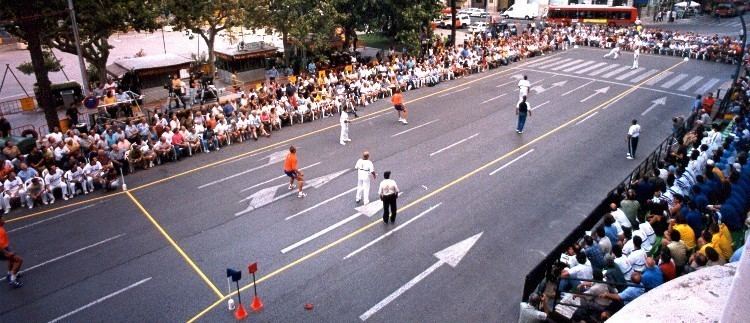 | ||
The International game (Valencian: joc internacional, [ˈdʒɔk ˌinteɾnasioˈnaɫ]) is a ball game modality that joins up many sports allegedly derived from the Jeu de paume. It's played in the Handball International Championships by teams from the Americas and Europe.
Contents
History
The International game was created so that players from similar sports could play with some minimal changes in their respective rules by the International Ball game Confederation.
In first instance, it was made by European federations of different and until then isolated sports:
Later on, some countries from the Americas joined:
Playing area
International game is played on a rectangular, flat surface (grass), 60 m long and 20 m wide (15 m at the "service" end). The endings of this rectangle are the "service" and the "receive" lines. In the "service" field there is a 8x6 m area, that's the "service box".
Ball
Every ball game is played with a different ball, and when writing the rules of this new sport a ball everybody could feel comfortable with was searched. Not as small and tough as the Valencian badana or as big and heavy as the Italian one.
It's played with a white rubber ball. No gloves or protections are allowed.
Rules
Two teams formed by 5 players play for 40 minutes to score more games by hitting a ball with the hand.
Every point consists in four points: 15, 30, 40 and game.
Every point begins when a rotating player from the team at the "service" field throws the ball from the "service box", after that players hit it in order to send it behind the opponent's end line or, at least, move it as far as possible.
If on the serve the ball surpassed the midfield the ball must be hit on the air or after the first rebound on the ground, but if the ball arrives bouncing before the midfield then there is no one-rebound limit.
When a team gets two "lines", or the score is "40 and 1 line", both teams must change their respective midfields.
The point may be attain directly or postponed.
Lines
Lines are a signal resting on a side of the field marking the place where a ball has been blocked so that it didn't advance any more in the defending team's area. When teams swap midfields (and, by that, passing to serve) the new serving team tries to attain the lines they did at the "receive field". In order to get them they must throw the ball surpassing that line so that it's blocked behind that line, then the postponed point is scored. If they don't get to send it so far or it's blocked in their own side of the line then it's the opponent team who obtains the point.
